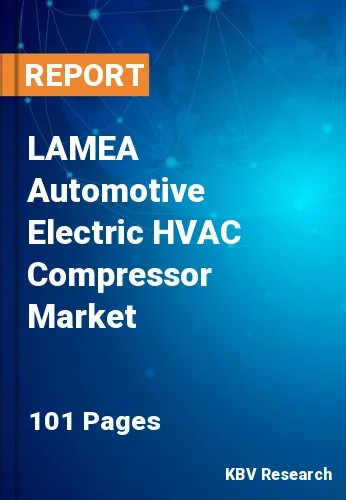Chapter 1. Market Scope & Methodology
1.1 Market Definition
1.2 Objectives
1.3 Market Scope
1.4 Segmentation
1.4.1 LAMEA Automotive Electric HVAC Compressor Market, by Vehicle Type
1.4.2 LAMEA Automotive Electric HVAC Compressor Market, by Drivetrain
1.4.3 LAMEA Automotive Electric HVAC Compressor Market, by Cooling Capacity
1.4.4 LAMEA Automotive Electric HVAC Compressor Market, by Country
1.5 Methodology for the research
Chapter 2. Market Overview
2.1 Introduction
2.1.1 Overview
2.1.2 Market Composition and Scenario
2.2 Key Factors Impacting the Market
2.2.1 Market Drivers
2.2.2 Market Restraints
Chapter 3. LAMEA Automotive Electric HVAC Compressor Market by Vehicle Type
3.1 LAMEA Passenger Vehicle Automotive Electric HVAC Compressor Market by Country
3.2 LAMEA Light Commercial Vehicle (LCV) Automotive Electric HVAC Compressor Market by Country
3.3 LAMEA Heavy Commercial Vehicle (HCV) Automotive Electric HVAC Compressor Market by Country
3.4 LAMEA Other Vehicle Type Automotive Electric HVAC Compressor Market by Country
Chapter 4. LAMEA Automotive Electric HVAC Compressor Market by Drivetrain
4.1 LAMEA Automotive Electric HVAC Compressor Hybrid Electric Vehicles (HEV) Market by Country
4.2 LAMEA Automotive Electric HVAC Compressor Plug-in Hybrid Electric Vehicles (PHEV) Market by Country
4.3 LAMEA Automotive Electric HVAC Compressor Battery Electric Vehicles (BEV) Market by Country
Chapter 5. LAMEA Automotive Electric HVAC Compressor Market by Cooling Capacity
5.1 LAMEA 20-40 CC Automotive Electric HVAC Compressor Market by Country
5.2 LAMEA Less Than 20 CC Automotive Electric HVAC Compressor Market by Country
5.3 LAMEA 40-60 CC Automotive Electric HVAC Compressor Market by Country
5.4 LAMEA Others Automotive Electric HVAC Compressor Market by Country
Chapter 6. LAMEA Automotive Electric HVAC Compressor Market by Country
6.1 Brazil Automotive Electric HVAC Compressor Market
6.1.1 Brazil Automotive Electric HVAC Compressor Market by Vehicle Type
6.1.2 Brazil Automotive Electric HVAC Compressor Market by Drivetrain
6.1.3 Brazil Automotive Electric HVAC Compressor Market by Cooling Capacity
6.2 Argentina Automotive Electric HVAC Compressor Market
6.2.1 Argentina Automotive Electric HVAC Compressor Market by Vehicle Type
6.2.2 Argentina Automotive Electric HVAC Compressor Market by Drivetrain
6.2.3 Argentina Automotive Electric HVAC Compressor Market by Cooling Capacity
6.3 UAE Automotive Electric HVAC Compressor Market
6.3.1 UAE Automotive Electric HVAC Compressor Market by Vehicle Type
6.3.2 UAE Automotive Electric HVAC Compressor Market by Drivetrain
6.3.3 UAE Automotive Electric HVAC Compressor Market by Cooling Capacity
6.4 Saudi Arabia Automotive Electric HVAC Compressor Market
6.4.1 Saudi Arabia Automotive Electric HVAC Compressor Market by Vehicle Type
6.4.2 Saudi Arabia Automotive Electric HVAC Compressor Market by Drivetrain
6.4.3 Saudi Arabia Automotive Electric HVAC Compressor Market by Cooling Capacity
6.5 South Africa Automotive Electric HVAC Compressor Market
6.5.1 South Africa Automotive Electric HVAC Compressor Market by Vehicle Type
6.5.2 South Africa Automotive Electric HVAC Compressor Market by Drivetrain
6.5.3 South Africa Automotive Electric HVAC Compressor Market by Cooling Capacity
6.6 Nigeria Automotive Electric HVAC Compressor Market
6.6.1 Nigeria Automotive Electric HVAC Compressor Market by Vehicle Type
6.6.2 Nigeria Automotive Electric HVAC Compressor Market by Drivetrain
6.6.3 Nigeria Automotive Electric HVAC Compressor Market by Cooling Capacity
6.7 Rest of LAMEA Automotive Electric HVAC Compressor Market
6.7.1 Rest of LAMEA Automotive Electric HVAC Compressor Market by Vehicle Type
6.7.2 Rest of LAMEA Automotive Electric HVAC Compressor Market by Drivetrain
6.7.3 Rest of LAMEA Automotive Electric HVAC Compressor Market by Cooling Capacity
Chapter 7. Company Profiles
7.1 Denso Corporation
7.1.1 Company Overview
7.1.2 Financial Analysis
7.1.3 Regional Analysis
7.1.1 Research & Development Expense
7.1.2 Recent strategies and developments:
7.1.2.1 Product Launches and Product Expansions:
7.2 Toyota Industries Corporation
7.2.1 Company Overview
7.2.2 Financial Analysis
7.2.3 Segmental Analysis
7.2.4 Recent strategies and developments:
7.2.4.1 Partnerships, Collaborations, and Agreements:
7.2.5 SWOT Analysis
7.3 Valeo SA
7.3.1 Company Overview
7.3.2 Financial Analysis
7.3.3 Segmental and Regional Analysis
7.3.4 Research & Development Expense
7.3.5 Recent strategies and developments:
7.3.5.1 Product Launches and Product Expansions:
7.3.6 Swot Analysis
7.4 Aptiv PLC
7.4.1 Company Overview
7.4.2 Financial Analysis
7.4.3 Segmental and Regional Analysis
7.4.4 Research & Development Expense
7.5 Panasonic Corporation
7.5.1 Company Overview
7.5.2 Financial Analysis
7.5.3 Segmental and Regional Analysis
7.5.4 Research & Development Expense
7.5.5 SWOT Analysis
7.6 Brose Fahrzeugteile SE & Co. KG
7.6.1 Company Overview
7.7 BorgWarner, Inc.
7.7.1 Company Overview
7.7.2 Financial Analysis
7.7.3 Regional & Segmental Analysis
7.7.4 Research & Development Expenses
7.7.5 Recent strategies and developments:
7.7.5.1 Partnerships, Collaborations, and Agreements:
7.8 Hanon Systems (Hahn & Co. Auto Holdings Co., Ltd.)
7.8.1 Company Overview
7.8.2 Financial Analysis
7.8.3 Regional Analysis
7.8.4 Research & Development Expense
7.8.5 Recent strategies and developments:
7.8.5.1 Partnerships, Collaborations, and Agreements:
7.8.5.2 Geographical Expansions:
7.9 Mahle GmbH (Mahle Stiftung GmbH)
7.9.1 Company Overview
7.9.2 Financial Analysis
7.9.3 Segmental and Regional Analysis
7.9.4 Research & Development Expense
7.9.5 Recent strategies and developments:
7.9.5.1 Geographical Expansions:
7.10. Sanden Holdings Corporation
7.10.1 Company Overview
7.10.2 Financial Analysis
7.10.3 Recent strategies and developments:
7.10.3.1 Geographical Expansions:
7.10.3.2 Partnerships, Collaborations, and Agreements:

